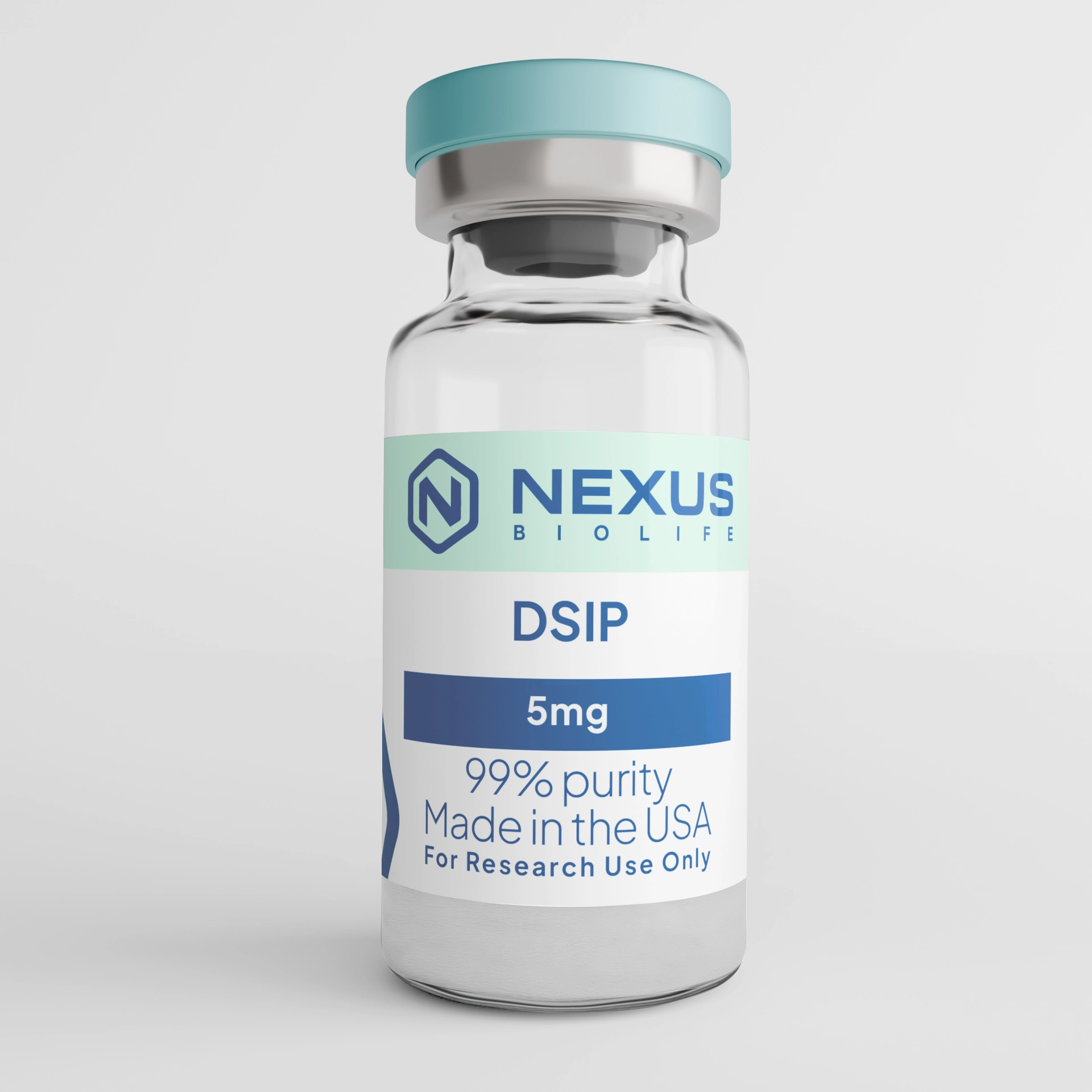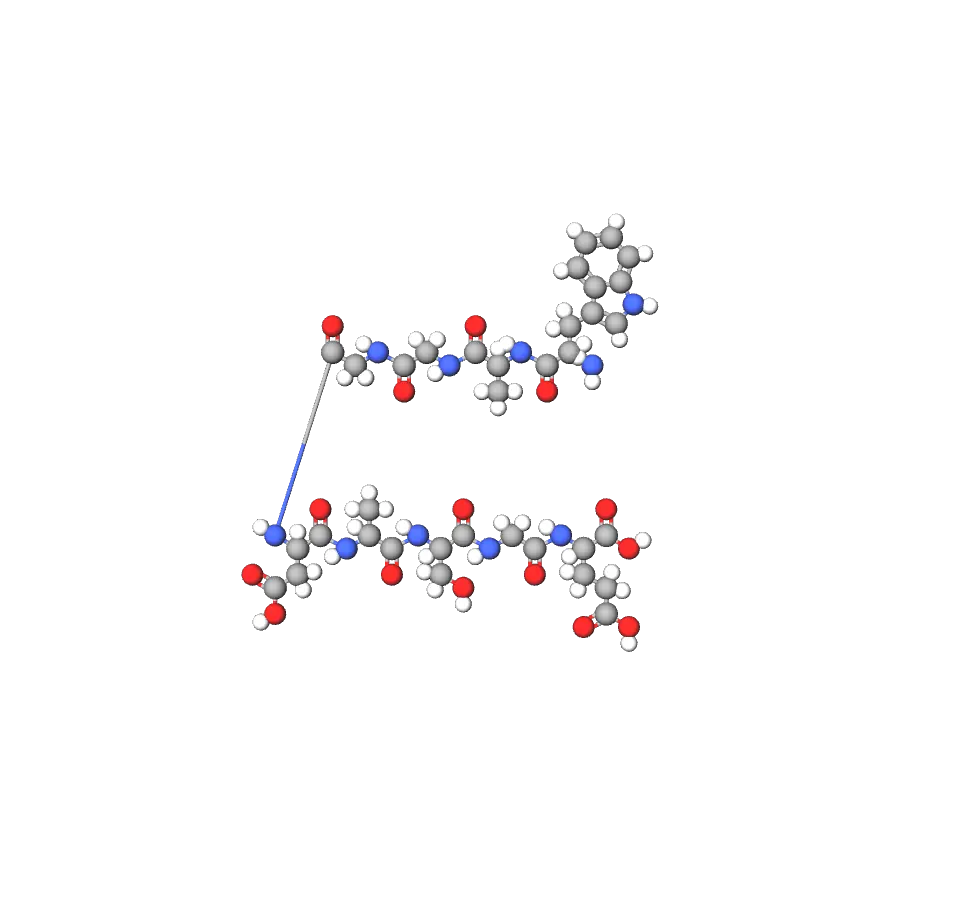
DSIP is a high-purity, synthetic nonapeptide. This product offers researchers a meticulously synthesized compound for laboratory studies. It is prepared to support detailed scientific investigations. DSIP is intended solely for research and development.

DSIP consists of nine amino acids in the sequence WAGGDASGE, resulting in a molecular weight of approximately 850 daltons and an amphiphilic nature that allows it to interact with both hydrophilic and hydrophobic environments in cellular systems. This structure sets it apart from other peptide families, contributing to its unique stability profile and biological interactions. In vitro, DSIP demonstrates low molecular stability, with a half-life of about 15 minutes due to degradation by aminopeptidase-like enzymes, suggesting it may form complexes with carrier proteins or precursors in biological contexts to enhance durability.
We provide DSIP as a high-purity lyophilized powder, typically verified at over 98% purity through HPLC and mass spectrometry, ensuring reliability for your experiments. Its solubility in aqueous buffers makes it suitable for reconstitution, but careful handling is advised to minimize exposure to enzymes that could accelerate breakdown. Unlike many peptides, DSIP's natural occurrence in free and bound forms across the hypothalamus, limbic system, pituitary, and peripheral tissues highlights its potential as a probe for studying peptide distribution and stability in diverse models. We're committed to transparency in our quality processes, so you can trust each batch for consistent performance in your lab work.
Delta Sleep-Inducing Peptide (DSIP) is a naturally occurring nonapeptide first isolated from the cerebral venous blood of rabbits in a state of induced sleep, serving as a valuable tool for exploring neuroendocrine regulation and sleep-related mechanisms in experimental settings. This amphiphilic peptide, with the amino acid sequence Trp-Ala-Gly-Gly-Asp-Ala-Ser-Gly-Glu, exhibits a range of physiological effects that extend beyond sleep induction, including influences on stress response and pain modulation, making it an intriguing subject for in-vitro and animal model research. As always, our DSIP is supplied strictly for research purposes and in-vitro use only—not for human consumption or any therapeutic applications.
While the precise mechanism of DSIP remains an area of ongoing investigation—often described as an unresolved riddle—research points to its involvement in modulating neurotransmitter systems and hormonal pathways. It may act through NMDA receptors in the brain, stimulate acetyltransferase activity via α1-adrenergic receptors, and interact with the MAPK cascade, showing homology to glucocorticoid-induced leucine zipper (GILZ) to influence ERK phosphorylation. Additionally, DSIP is regulated by glucocorticoids and has been observed to inhibit somatostatin release from the median eminence in vitro, potentially affecting growth hormone dynamics.
In animal models, DSIP's effects are circadian-dependent, impacting thermoregulation, heart rate, blood pressure, pain thresholds, and the lymphokine system, sometimes manifesting before overt signs of sleep. For instance, it can restrict stress-induced changes in mitochondrial monoamine oxidase type A activity and serotonin levels, or enhance hypothermia induced by certain serotonin receptor agonists. These actions suggest DSIP or DSIP-like peptides may prepare peripheral physiological mechanisms for sleep onset or stress adaptation. We enjoy breaking down these complexities—think of DSIP as a subtle regulator in the intricate web of neuroendocrine signaling, ready for you to explore in controlled assays.
In wrapping up, DSIP emerges as a fascinating nonapeptide for unraveling the mysteries of sleep induction, stress modulation, and beyond, with its unique structure and multifaceted effects offering rich avenues for in-vitro exploration. Though aspects like its exact mechanism remain a puzzle, its potential in research models underscores our passion for advancing peptide science through quality products and shared knowledge. Remember, DSIP is solely for in-vitro research—not for human use—and we're your steady partner in navigating these complexities with integrity and approachability. Together, let's continue demystifying the science, one insightful study at a time.
DSIP's versatility makes it a compelling choice for in-vitro and ex-vivo studies focused on sleep regulation, stress resilience, and neuroendocrine function. In cellular models, it has been used to investigate peptide degradation pathways, given its short half-life and potential interactions with enzymes like aminopeptidases. Researchers have also fused DSIP with carrier proteins for expression and purification studies, enhancing its utility in recombinant systems to probe stability and activity.
In animal research, DSIP has been applied to models of sleep disturbance, where it induces delta EEG activity and reduces motor activities in rabbits, or improves sleep efficiency and latency in certain contexts. Its potential in stress and pain paradigms is notable, with studies showing modulation of wakefulness and sleep-wake cycles over 24 hours, or alleviation of experimentally induced stress. Furthermore, DSIP analogues have demonstrated slow-wave sleep promotion in rabbits and rats, while structurally similar peptides like dermorphin exhibit comparable effects. Beyond sleep, applications include exploring anticonvulsant properties in epilepsy models, analgesic effects in pain assays, and even geroprotective or anticarcinogenic outcomes in mice. Our educational approach encourages using DSIP responsibly in these areas, and we're happy to share insights on protocol optimization to support your discoveries.
To maintain DSIP's integrity for your research, store the lyophilized powder at -20°C or below in a dry, light-protected environment to prevent degradation. For reconstitution, we recommend using sterile water or a neutral buffer to reach concentrations of 1-2 mg/mL, gently mixing to avoid foaming that could accelerate enzymatic breakdown. Given its in-vitro half-life of around 15 minutes, prepare fresh solutions for each experiment and consider protease inhibitors if extending stability is needed.
Once reconstituted, aliquot and freeze portions for short-term use, but prioritize fresh preparations to ensure reproducible results. Our rigorous testing minimizes impurities, but always check pH and clarity before assays. If questions arise about storage or handling, our team is here with logical, evidence-based advice to keep your work on track.
Delta Sleep-Inducing Peptide (DSIP) is a naturally occurring nonapeptide first isolated from the cerebral venous blood of rabbits in a state of induced sleep, serving as a valuable tool for exploring neuroendocrine regulation and sleep-related mechanisms in experimental settings. This amphiphilic peptide, with the amino acid sequence Trp-Ala-Gly-Gly-Asp-Ala-Ser-Gly-Glu, exhibits a range of physiological effects that extend beyond sleep induction, including influences on stress response and pain modulation, making it an intriguing subject for in-vitro and animal model research. As always, our DSIP is supplied strictly for research purposes and in-vitro use only—not for human consumption or any therapeutic applications.
While the precise mechanism of DSIP remains an area of ongoing investigation—often described as an unresolved riddle—research points to its involvement in modulating neurotransmitter systems and hormonal pathways. It may act through NMDA receptors in the brain, stimulate acetyltransferase activity via α1-adrenergic receptors, and interact with the MAPK cascade, showing homology to glucocorticoid-induced leucine zipper (GILZ) to influence ERK phosphorylation. Additionally, DSIP is regulated by glucocorticoids and has been observed to inhibit somatostatin release from the median eminence in vitro, potentially affecting growth hormone dynamics.
In animal models, DSIP's effects are circadian-dependent, impacting thermoregulation, heart rate, blood pressure, pain thresholds, and the lymphokine system, sometimes manifesting before overt signs of sleep. For instance, it can restrict stress-induced changes in mitochondrial monoamine oxidase type A activity and serotonin levels, or enhance hypothermia induced by certain serotonin receptor agonists. These actions suggest DSIP or DSIP-like peptides may prepare peripheral physiological mechanisms for sleep onset or stress adaptation. We enjoy breaking down these complexities—think of DSIP as a subtle regulator in the intricate web of neuroendocrine signaling, ready for you to explore in controlled assays.
In wrapping up, DSIP emerges as a fascinating nonapeptide for unraveling the mysteries of sleep induction, stress modulation, and beyond, with its unique structure and multifaceted effects offering rich avenues for in-vitro exploration. Though aspects like its exact mechanism remain a puzzle, its potential in research models underscores our passion for advancing peptide science through quality products and shared knowledge. Remember, DSIP is solely for in-vitro research—not for human use—and we're your steady partner in navigating these complexities with integrity and approachability. Together, let's continue demystifying the science, one insightful study at a time.
DSIP consists of nine amino acids in the sequence WAGGDASGE, resulting in a molecular weight of approximately 850 daltons and an amphiphilic nature that allows it to interact with both hydrophilic and hydrophobic environments in cellular systems. This structure sets it apart from other peptide families, contributing to its unique stability profile and biological interactions. In vitro, DSIP demonstrates low molecular stability, with a half-life of about 15 minutes due to degradation by aminopeptidase-like enzymes, suggesting it may form complexes with carrier proteins or precursors in biological contexts to enhance durability.
We provide DSIP as a high-purity lyophilized powder, typically verified at over 98% purity through HPLC and mass spectrometry, ensuring reliability for your experiments. Its solubility in aqueous buffers makes it suitable for reconstitution, but careful handling is advised to minimize exposure to enzymes that could accelerate breakdown. Unlike many peptides, DSIP's natural occurrence in free and bound forms across the hypothalamus, limbic system, pituitary, and peripheral tissues highlights its potential as a probe for studying peptide distribution and stability in diverse models. We're committed to transparency in our quality processes, so you can trust each batch for consistent performance in your lab work.

DSIP's versatility makes it a compelling choice for in-vitro and ex-vivo studies focused on sleep regulation, stress resilience, and neuroendocrine function. In cellular models, it has been used to investigate peptide degradation pathways, given its short half-life and potential interactions with enzymes like aminopeptidases. Researchers have also fused DSIP with carrier proteins for expression and purification studies, enhancing its utility in recombinant systems to probe stability and activity.
In animal research, DSIP has been applied to models of sleep disturbance, where it induces delta EEG activity and reduces motor activities in rabbits, or improves sleep efficiency and latency in certain contexts. Its potential in stress and pain paradigms is notable, with studies showing modulation of wakefulness and sleep-wake cycles over 24 hours, or alleviation of experimentally induced stress. Furthermore, DSIP analogues have demonstrated slow-wave sleep promotion in rabbits and rats, while structurally similar peptides like dermorphin exhibit comparable effects. Beyond sleep, applications include exploring anticonvulsant properties in epilepsy models, analgesic effects in pain assays, and even geroprotective or anticarcinogenic outcomes in mice. Our educational approach encourages using DSIP responsibly in these areas, and we're happy to share insights on protocol optimization to support your discoveries.
To maintain DSIP's integrity for your research, store the lyophilized powder at -20°C or below in a dry, light-protected environment to prevent degradation. For reconstitution, we recommend using sterile water or a neutral buffer to reach concentrations of 1-2 mg/mL, gently mixing to avoid foaming that could accelerate enzymatic breakdown. Given its in-vitro half-life of around 15 minutes, prepare fresh solutions for each experiment and consider protease inhibitors if extending stability is needed.
Once reconstituted, aliquot and freeze portions for short-term use, but prioritize fresh preparations to ensure reproducible results. Our rigorous testing minimizes impurities, but always check pH and clarity before assays. If questions arise about storage or handling, our team is here with logical, evidence-based advice to keep your work on track.
